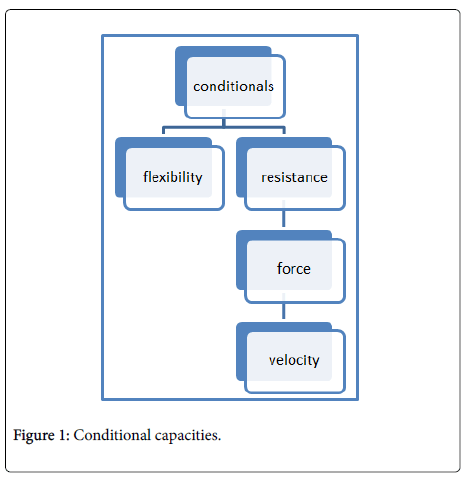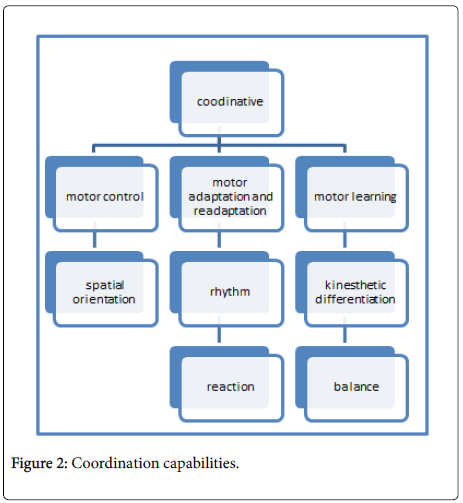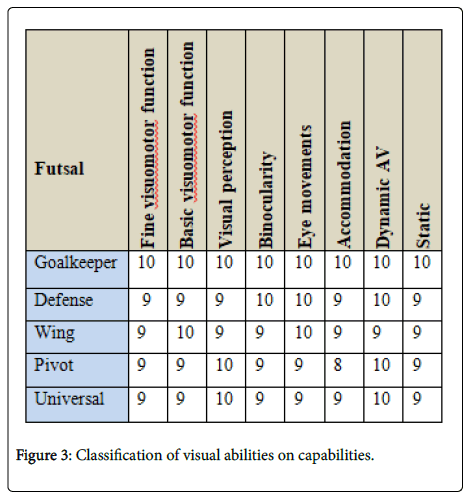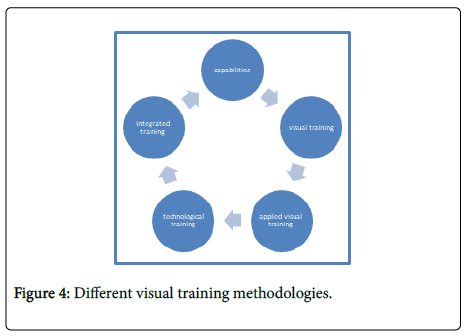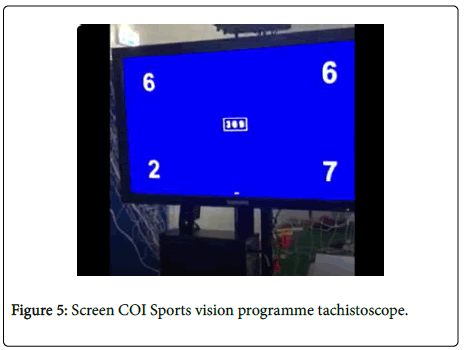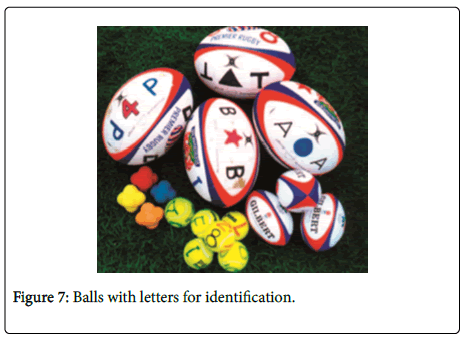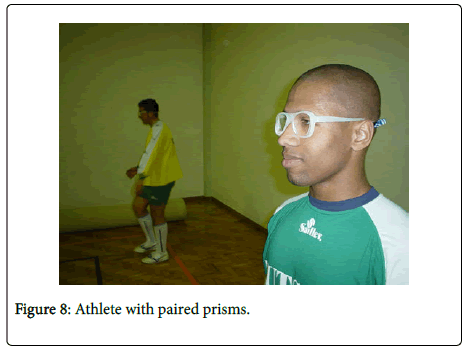Bases of Sports Visual Training: A Review
Received: 18-Feb-2020 / Accepted Date: 03-Mar-2020 / Published Date: 10-Mar-2020 DOI: 10.4172/2476-2075.1000137
Abstract
The vision and sports are an increasingly important topic among optometrists. Article aims to highlight the practices that are being carried out within the scope of sports visual training through a literature review that aims to be an initiation base for optometrists who want to start their activity in this area.
Sports visual training is an area that has been growing and where its results have been proven, being an important tool for an optometry professional. For acting in this area, it is important to keep in mind the bases of action and it is in this area that we will focus throughout this article.
Keywords: Sport visual training; Sport skills; Visual abilities; Optometrist
Introduction
With the sport visual training, it is intended to improve the visual abilities of athletes and consequently their sports performance [1].
In general terms, "an improved vision" can raise income levels during the sports process, in any case it is necessary to bear in mind what this vision is, since depending on the sport so the skills needed for its performance to the highest Level.
Visual training has been a recurring practice in the United States of America and recently it has been proven through studies of its effectiveness. Recent studies carried out with strobe glasses have enabled improvements in the visual performance of athletes [2,3].
It is known that athletes need a good vision to have good sports performances, it is known that many athletes perform sports visual training on their own initiative in order to increase their sports performance [1].
According to a study carried out on gymnasts, it was found that the increase in skills in saccadic eye movements can have implications for dynamic balance, also demonstrating the importance that coaches have in this type of tasks and how their collaboration can be crucial for the increase performance at this level. The trainer must work in harmony with the optometrist and the training plans must be synchronized with the visual therapy exercises [4].
Visual Training Objectives
The optometrist who wants to go through this area can choose two paths; one of them is what transforms visual therapy and gives it a character, not rehabilitation but capacity development; another is to thoroughly perceive, in collaboration with the coach, the needs of his athletes and develops training and therapies together that improve the visual skills related to this sport [4].
For any sport there is a need to train physical skills. Physical abilities are divided into conditional and coordinating (Figures 1 and 2) [1-3]. In modern training, these skills often train in the context of play and thus make sense that the training provided by the optometrist takes this into account, since it will have to appeal to a lot of creativity to do so in an integrated way.
Conditional motor capacities are:
Resistance
Resistance is the ability to withstand and recover psychic fatigue and especially physics. Resistance is manifested according to the specificity of the sport:
Base resistance: is the ability to perform over a long period, a load correlated with the specific performance of the competition, and that requires the use of many muscle groups.
Resistance specifies: is the ability that allows the sportsman to maintain a high level of performance during competition in the modality concerned.
According to bioenergetic mobilization forces:
Aerobic resistance: presupposes a balance between the oxygen that is being necessary for muscle work and what is being transported in circulation to muscle tissue.
Anaerobic resistance: due to the high intensity of the load, energy metabolism is processed in oxygen debt. Thus, energy is also mobilized by anoxidative route.
According to the duration of the effort:
Short-lived resistance: which at maximum loads is between 45 seconds and 2 minutes. The necessary energy is obtained essentially through anaerobic metabolism.
Medium-duration resistance: activity or modality that requires efforts between 2 and 8 minutes. Energy is obtained through aerobic/ anaerobic mixed metabolism.
Long-term resistance: activities, modalities or disciplines, in which the duration of exertion is greater than 8 minutes, and energy is obtained essentially through aerobic metabolism.
Strength
Strength is the ability that allows you to react against resistance through muscle contraction. Thus facilitates, among other efforts: jump, push, lift and pull. The development of force can be:
Maximum strength: is the highest force an individual can develop with a maximum voluntary contraction, which can be; static or dynamic.
Fast or fast force: is the fastest force you can develop voluntarily and per unit of time to perform a predetermined movement. This may be; explosive or resistant.
Speed
Speed is the ability to perform movements from the inside out in the shortest time. It is the ability to perform motor actions for at least time, with maximum intensity and lasting not exceeding 8 seconds. Speed can be introduced as the ability to perform a movement in less time as possible. This may be; cyclic maximum or acyclic maxim.
Flexibility
Flexibility is the athlete's ability to perform along the entire range the joint of movements by himself or by influence of external forces. It can be; general or specifies.
The coordinating capabilities are:
1. Motor control: The ability to be able to meet the requirement of high precision in movements, from a spatial, temporal and dynamic point of view.
2. Reaction: It is the ability to be able to react as quickly and correctly as possible to a given stimulus.
3. Rhythm: It is the ability to understand, accumulate and interpret temporal and dynamic structures intended or contained in the evolution of movement.
4. Kinesthetic differentiation: It is the ability to differentiate information from muscles, tendons and ligaments that inform us about our body's position at a given time and space and allows us to perform motor actions in a correct and economic way, thus achieving the coordination of movements.
5. Spatial orientation: It is the ability to react to an external stimulus in terms of displacement or postural stabilization.
6. Adaptation and motor readaptation: These are the ability to correctly adapt a combination of actions that unfold sequentially or simultaneously.
7. Motor learning: It is the ability to create their own movements in an aesthetic and artistic way.
8. Balance: It is the ability to keep the body in a normal relationship with the soil, developing reflexes to adapt the body to movement.
They are capacities determined by the metabolic energy processes (obtaining and transforming energy), so they are capacities conditioned by the energy available in the muscles and the mechanisms that regulate their distribution.
These are capacities determined by the processes of organization, control and regulation of movement. Are conditioned by the ability of the analysers to elaborate the information involved in the formation and realization of a body movement.
To know and be aware of what is done in terms of training, the sports optometrist must be part of the technical team, at a level identical to what is happening with the physiotherapist, to cite an example.
A sport and a team that makes statistics will undoubtedly be an added value to check the evolution of the athlete in all its aspects.
From studies carried out and in a generalized, the needs of sportsmen in visual terms are at the level of:
Thin visuo-motor function and basic visuo-motor function
Visual motor skills, also known as visual motor integration, are the skills that emerge from the integration of visual abilities, visual perceptive abilities and motor skills that allow us to use our eyes and hands in a coordinated and efficient manner. Visual motor skills are the basis for many of a child's everyday activities, including cutting, coloring, writing, grabbing or kicking a ball or tying their shoes. When visual systems and motors communicate efficiently, these activities are easy to achieve.
When these systems are not communicating effectively, there will be difficulties with many of these activities. An athlete may not have visual problems with acuity or perception and may not have problems with the strength or dexterity of the hand, but the connection between the visual system and motor is not as organized or efficient as it should, resulting in difficulties with the "Visual motor skills". The functional implications of weak visual motor abilities include difficulty with writing, drawing, completion of mazes, copying of the board at school, and lack of vision.
Visual perception
To realize is to interpret the information that conveys our meanings to us about what surrounds us. Moreover, the interpretation we make depends on our cognitive processes and our previous knowledge. Visual perception can be defined as the ability to interpret the information that visible spectrum light casts into our eyes. The result of our brain's interpretation of this information is what we know as visual perception or vision. Thus, visual perception is a process that begins in our eyes:
Photoreception: Rays of light enter through our pupils and excite the receiving cells that lie in the retina.
Basic transmission and processing: The signals that produce these cells are transmitted through the optic nerve to the brain. First step the optical chiasma (where the information from the right visual field will go to the left hemisphere, while the information from the left visual field will go to the right hemisphere) and then the information emits on the lateral geniculate nucleus of the thalamus.
Preparation of information and perception: Finally, the visual information captured by our eyes is sent to the visual covers of the occipital lobe. In these brain structures, the information is elaborated and sent to the rest of the brain to allow us to interact with it.
Binocularity: The binocular view of humans results from the almost complete superposition of the visual fields of each eye, which causes perceptual discrimination of spatial locations of objects relative to the observer (egocentric location) much thinner (stereopsis), but this occurs only in a very narrow band (the horopter). Below and beyond, diplopia and confusion are present, and physiological suppression (cortical) is necessary to avoid them. We analyze the geometry of the horopter and its physiological implications (the Hillebrand deviation, the Kundt partition, the Panum area), as well as clinical aspects of normal binocular vision (simultaneous perception, fusion, stereoscopic vision) and adaptations to its affected states (pathological suppression, amblyopia, anomalous visual correspondence) [5].
Eye movements: There are six extraocular muscles that move the eye: the upper rectum, medial, lower rectum and lower oblique (innervated by the oculomotor or common ocular motor, III cranial nerve), the upper oblique (invalid by the trochlear, IV cranial nerve) and the lateral rectum (innervated by abducent, VI cranial nerve). The lower oblique muscle originates in the anterior portion of the orbit. The other five extrinsic eye muscles originate in the Zinn ring [6].
The exploration of the functioning of the muscles of both the eye synergistically is fundamental for a good performance of the stereoscopic function of the athlete, and should be analyzed in relation to the deductions, versions and vergences.
Accommodation
The normal young eye can easily focus closely and far objects, that is, it can alter focus or accommodate. The word accommodation has a relatively recent origin and was definitely introduced by Burow in 1841 [7].
Static AV and dynamic AV: Static visual acuity, stroke, is defined as the ability to distinguish the details of static objects whose image forms in the retina when the evaluated subject is also at rest. By evaluating this capacity, we can consider four basic thresholds:
Minimum umbral detectable, (ability to perceive the smallest object in the visual field).
Resolutive minimum umbral (ability to perceive as separate, two very close objects).
Threshold minimum perceptible of alienation, (referring to the detection capacity of the disposal between two discontinuous segments, whose extremes are very close to each other, acuity Vernier.
Umbral minimum recognizable, (ability to adequately identify the shape or orientation of an object, for example a letter, identifying this umbral with what we currently call visual acuity (Chan and Courtney, 1996) [8].
The term dynamic visual acuity, AvD, was described in 1949 by Ludvig and Miller to describe the ability to visually resolve subtle spatial details of an object when it, the observer or both are on the move (Miller and Ludvigh, 1962).
The visual science dictionary defines AVD as the ability to discriminate details of an object when there is relative movement between it and the observer (Cline, Hofstetter and Griffin, 1980).
For each sport we must classify these aspects, depending on the specificity of the player within the team (Figure 3).
In this table of Figure 3, the vision specialist and the coach define the importance of each visual ability, ranking it from 0 to 10 in relation to each player role. To train these skills according to the needs of the players.
To train these skills we can do it in different ways and even integrate them all (Figure 4).
The different training components make a better athlete. Motor skills training, standard visual training, athletes applied visual training, new applied technologies and integrated visual training with their sport training unit.
The stages of sports visual training
Visual training: Based on the results obtained in the optometric examination, perception, visual information processing and athlete's needs, a personalized exercise program is designed to develop and maximize the visual skills and their integration with the athlete. rest of the senses. In this way we can change the way of using the visual system and as a result improve the overall performance of the athlete.
Applied visual training: In this type of training are applied instruments and techniques that can approach the specific training of each sport, promoting the speed of reaction and coordination, with special emphasis on Propriocetivity. In this visual training can be used computerized programs or electronic platforms like COI Sports (Figure 5).
Technological training: application of instruments such as eye traking, stroboscopy and stabilometric plates (Figure 6), to improve the athlete's visual performance and control his own training.
Integrated training: Putting into practice some visual training exercises (Figure 7).
Through visual training in adapted optometry cabinet, visual training applied using the sports strands in question, visual training integrating new technologies such as Eye Tracking systems e.g. and integrated training using optometric techniques in specific training context [9-13].
Example of visual training integrated into American Football Training Unit [9]:
Exercise 1: cover one of the athlete's eyes with a surgical adhesive and use in training that requires pass and reception. This simple occlusion makes athletes forced to rotate their heads and shoulders toward the target, a basic body positioning ability that is responsible for many of the sports errors such as; Rugby, Football or Basketball.
Exercise 2: Use different ball sizes marked with different numbers and symbols, we ask the athlete to receive the ball that identifies it, by its letter or symbol, as soon as possible before reaching his hands (coordination and accommodation training).
Balls of different sizes and colours with printed letters of different sizes and colours, for training de accommodation in same time with coordination with parallel prisms we alter the athlete's spatial perception helping him to correct calculation errors.
Exercise 3: Use the previous exercise with the help of paired prisms (Figure 8), changing the athlete's spatial perception. (Spatial perception training).
We must never forget that before training vision it should have the basic skills normalized.
Conclusion
Sports visual training is undoubtedly an important area of optometry whose effectiveness has been proven over the years, through studies carried out in the field of sport.
The implementation of this type of practice is only possible with the collaboration of the athletes' coaches, but the practice and knowledge of the optometrist in this area is undoubtedly fundamental and an asset for athletes and other professionals involved in the sport.
How to advance new technologies and using programs that enhance visual skills has been witnessing the evolution of sports visual training.
References
- Appelbaum LG, Erickson G (2018) Sports vision training: A review of the state-of-the-art in digital training techniques. International Review of Sport and Exercise Psychology. Routledge 11:160–189.
- Wilkins L, Gray R (2015) Effects of stroboscopic visual training on visual attention, motion perception, and catching performance. Percept Mot Skills 121:57–79.
- Hülsdünker T, Rentz C, Ruhnow D, Käsbauer H, Strüder HK, et al. (2019) The effect of 4-week stroboscopic training on visual function and sport-specific visuomotor performance in top-level badminton players. Int J Sports Physiol Perform 14:343–350.
- Shokry MH (2017) Effect Of Visual Skills Training On Saccadic Eye Movements And Performance Level Of Vault For Junior Gymnasts. Vol. XVII.
- Leonardo W, Fernando T, Frederico P, Liliana W (2000) Physiology of Accommodation and Presbiopya.
- Llusa Q, Antonio JAC, José Aparecido DS (2018) Dynamic Visual Acuity. Trends Psychol 26.
- Reichow AW, Stoner MW (1993) Sports Vision; Introduction to behavioral optometry. Optometric Extension Program.
- Press LJ (2012) Parallels Between Auditory & Amp; Visual Processing. Optometric Extension Programe Foundation.
- Bleything WB (1998) Developing the dynamic vision therapy pratice. Optometric extension Program Foundation.
- Michael F, Zupan, Alan W, Arata, Alfred WMS, et al. (2006) Visual adaptations to sports vision enhancement training clinical. Clinical Sports Vision.
- Bruce AA, Joanne M, Wood B (2010) Do generalized visual training programmes for sport really work? An experimental investigation.
Citation: Nascimento H, Roque ADC (2020) Bases of Sports Visual Training: A Review . Optom Open Access 5: 135. DOI: 10.4172/2476-2075.1000137
Copyright: © 2020 Nascimento H, et al. This is an open-access article distributed under the terms of the Creative Commons Attribution License, which permits unrestricted use, distribution, and reproduction in any medium, provided the original author and source are credited.
Select your language of interest to view the total content in your interested language
Share This Article
Recommended Journals
Open Access Journals
Article Tools
Article Usage
- Total views: 4029
- [From(publication date): 0-2020 - Dec 20, 2025]
- Breakdown by view type
- HTML page views: 3107
- PDF downloads: 922

